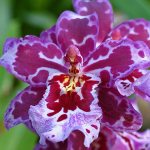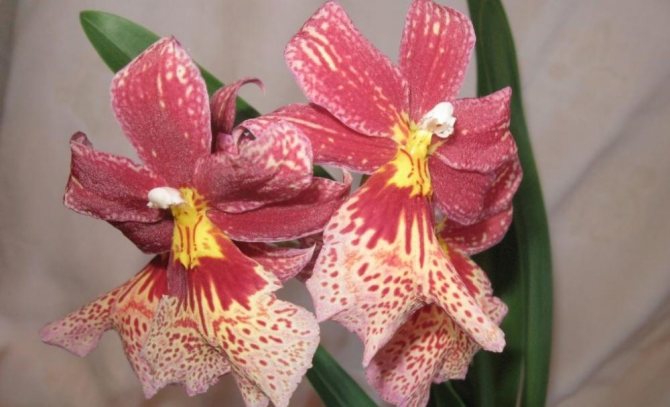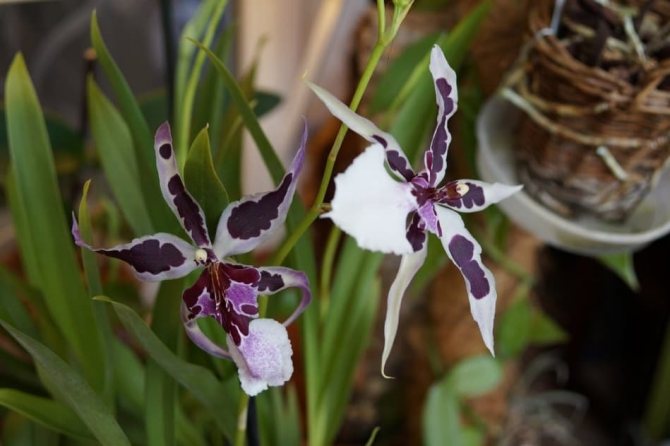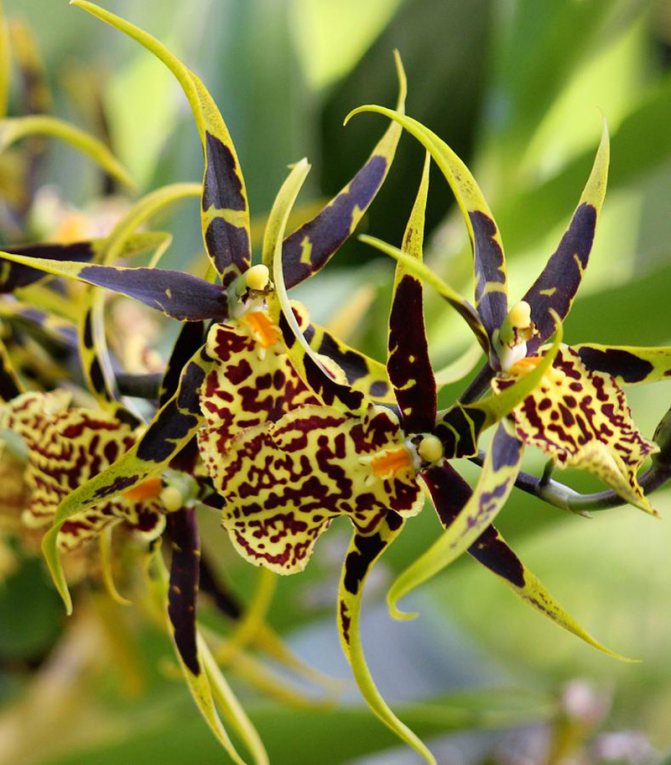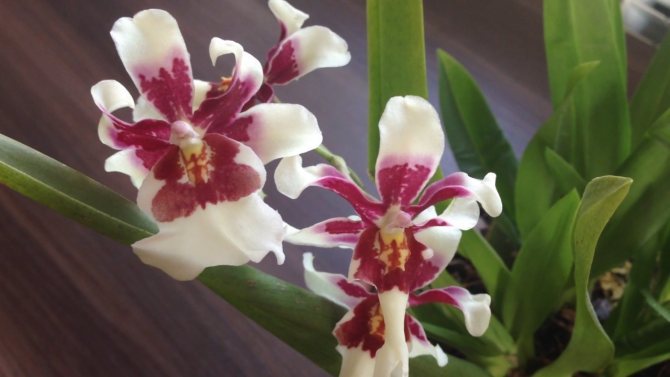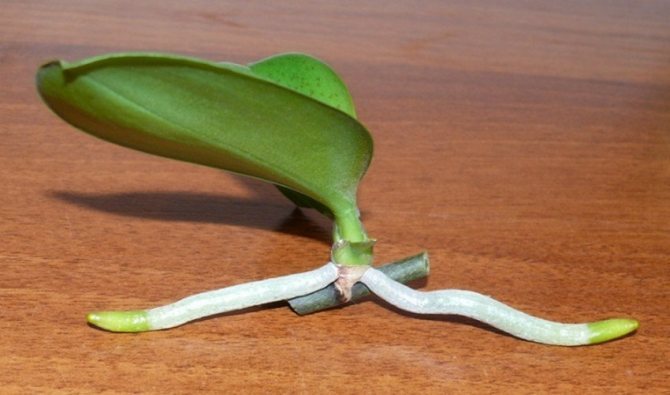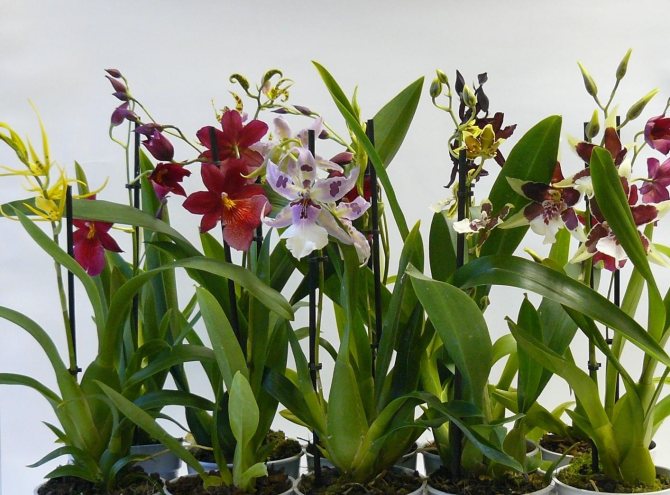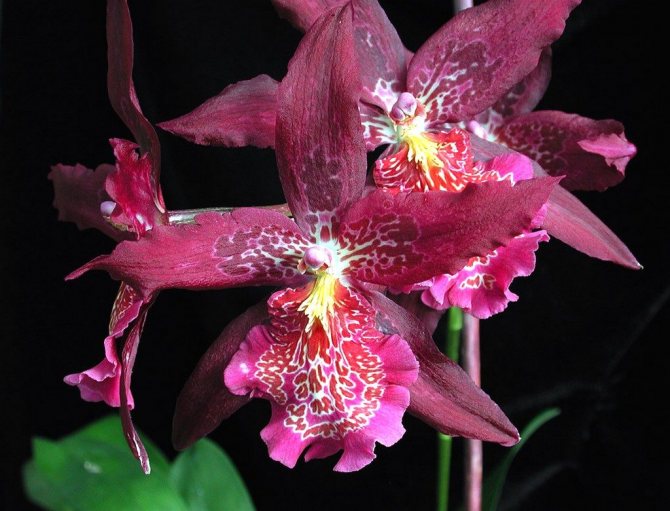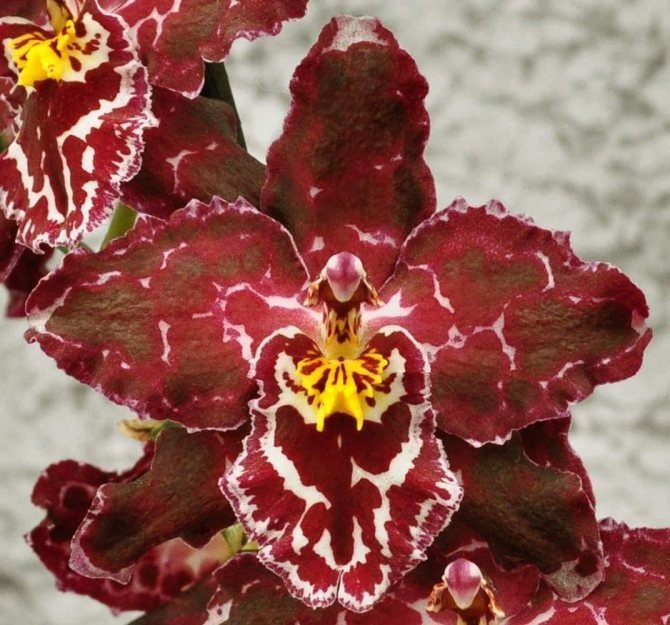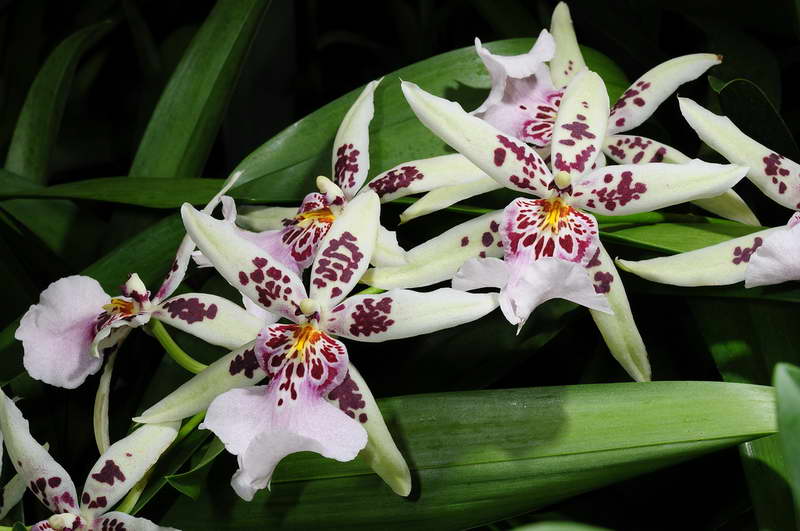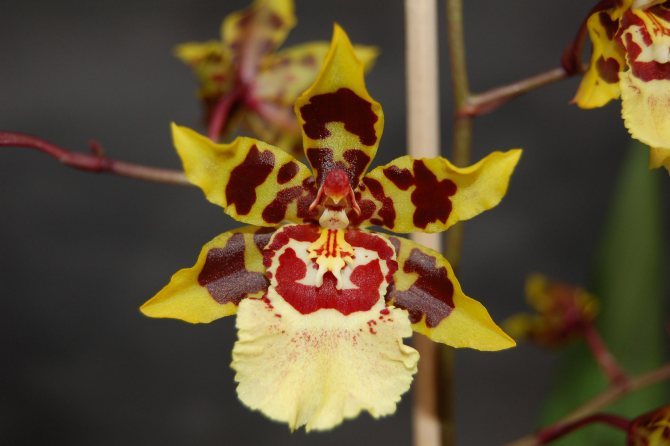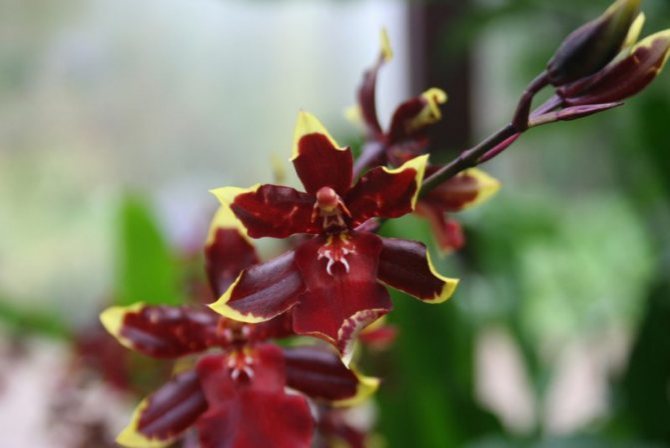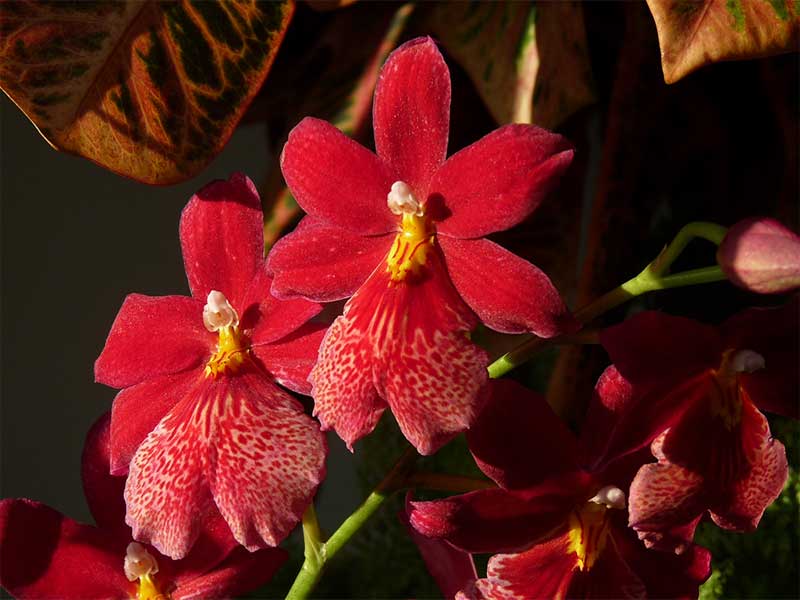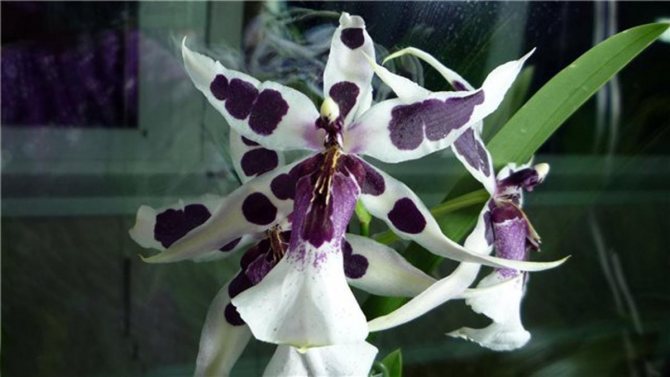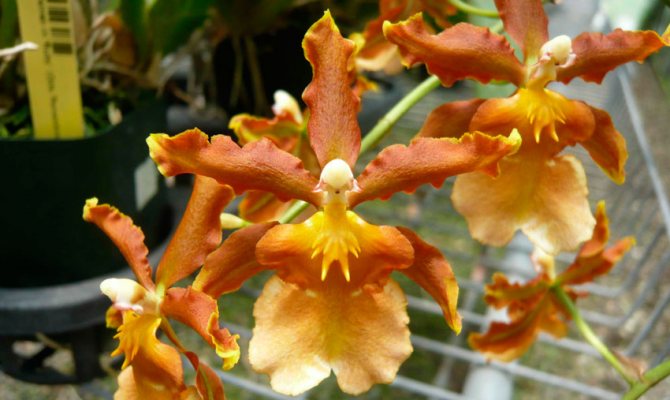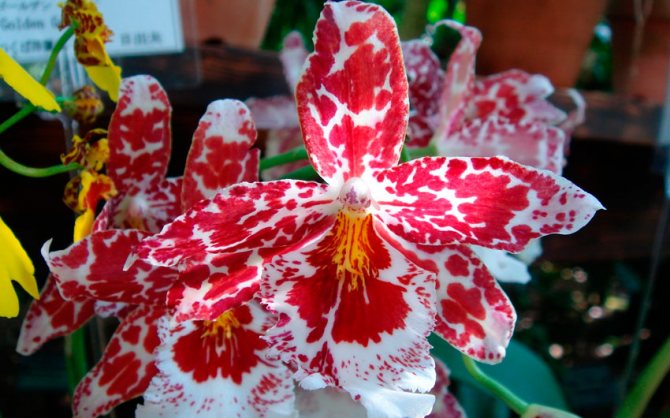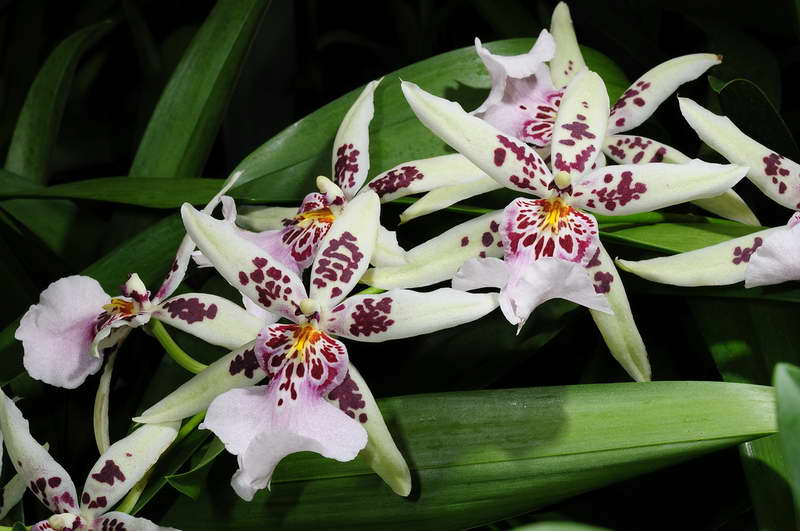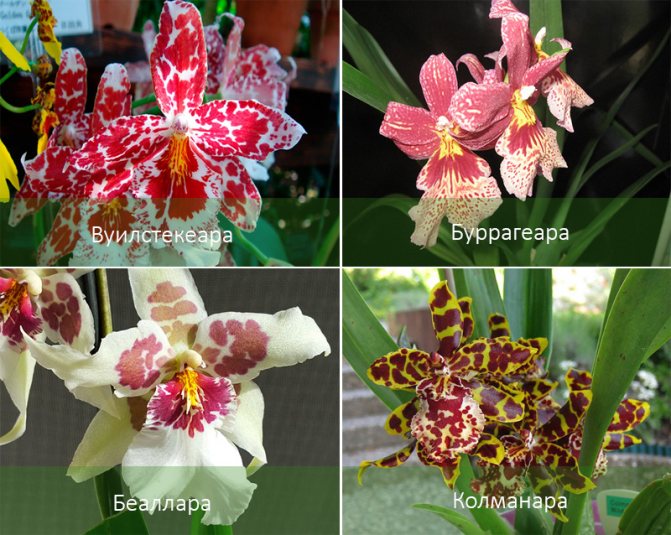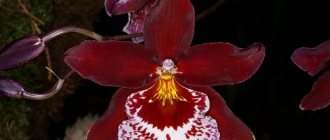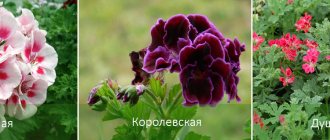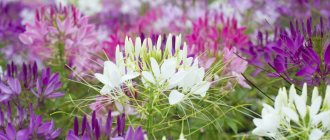Description of the plant
The Cambria Orchid is an artificially bred hybrid that does not occur in nature. The plant is characterized by the presence of rounded pseudobulbs, and it also has narrow and long leaves that are dark green in color. The indoor flower is characterized by shoot growth.
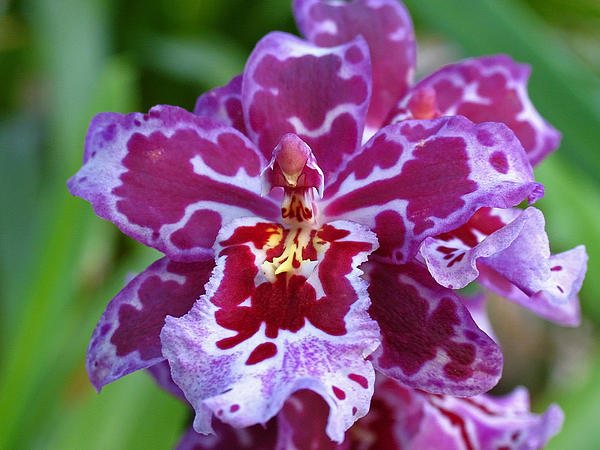
The shape of the flowers of the culture is quite diverse. They can be star-shaped or rounded. The size of the flowers can be 1-10 centimeters. The flowers of the plant are characterized by yellow, brown, purple or red color.
Video: how to choose the right cambria orchid
Description and distinctive features of cambria
Cambria has a second name - an asterisk, because of the shape of the flowers. Distinctive features of the orchid:
- pseudobulbs of a round or oblong shape, up to 8 cm;
- tapered sheet plates;
- shoot type of growth;
- one of the lateral axes grows very quickly and becomes the main one, as a result of which the second one shifts or dies;
- on false bulbs, two or three dark green leaves with a vein in the center, reaching 0.5 m;
- flowers of different shades with splashes, with a diameter of 50 mm-10 cm.
Views
There are several varieties of the Cambria orchid.
The most popular types include:
- Beallara, a complex species, in the crossing of which four genera of orchids took part (Miltonia, Brassia, Odontoglossum, Kohlioda);
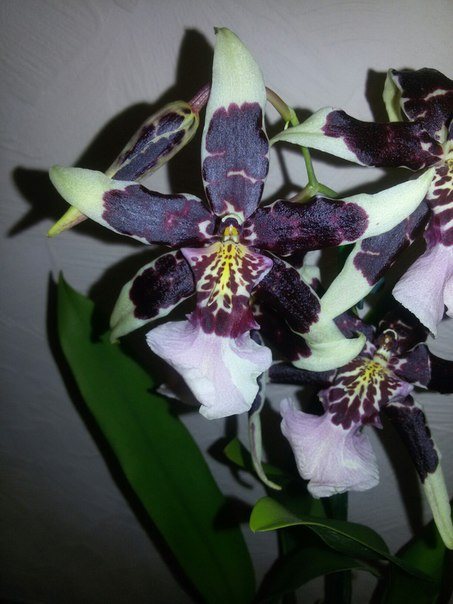

- Burrageara - a complex species, which was obtained by crossing 4 species (Miltonia, Oncidium, Odontoglossum and Kohlioda);


- Colmanara - received by crossing 3 types of orchids: Odontoglossum, Miltonia and Oncidium;


Due to the large number of cambrian orchid species, a florist can choose the most suitable option for himself.
Video: how to distinguish which hybrid Cambria belongs to.
Sometimes (erroneously) cambrian orchid varieties are referred to as Miltassia, but it is crossed by two pure genera of orchids: Miltonia and Brassia - and, therefore, is their variety, i.e. Miltassia is not Cambria.
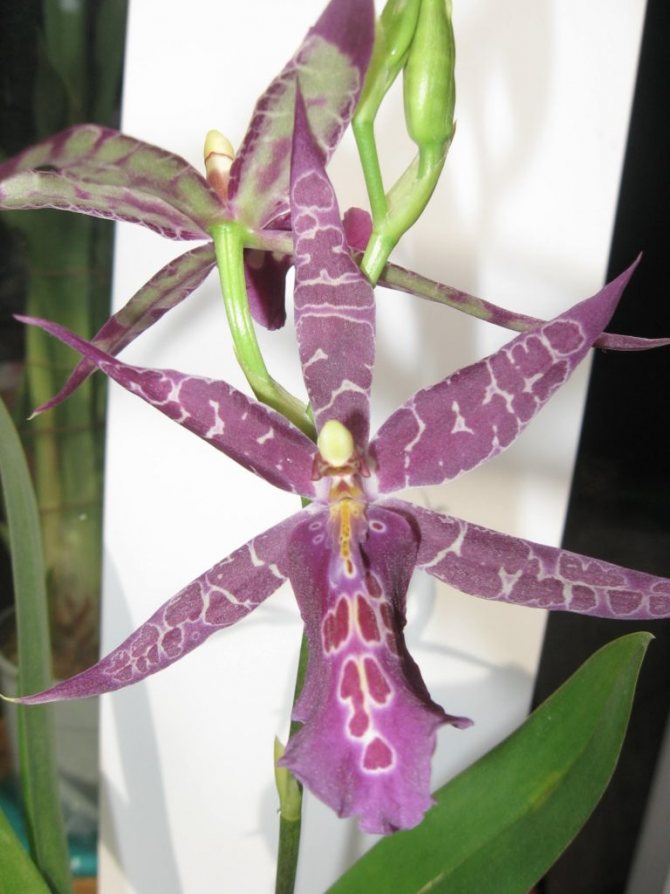

Growing conditions
In order to ensure abundant flowering and rapid growth of the cambrian orchid, it needs to create optimal conditions for growing and keeping, which are given in the table.
| Condition | Content |
| Lighting | Cumbria is a light-loving plant, which is why it must be grown in a well-lit place. At the same time, it is strictly forbidden to allow the influence of ultraviolet radiation on the culture. This is due to the possibility of getting burns in the summer, which leads to yellowing of the cambrian leaves. That is why, if the flower is installed on a south or southeast window, it must be shaded with gauze. The ideal option would be to install the plant on east or west windows. If insufficient lighting is observed in winter, then the flower is placed in the brightest place. If necessary, additional lighting of cambria is organized using phytolamps. Daylight hours should be between 10 and 12 hours. During the dormant period, the culture does not need additional lighting. |
| Temperature | To ensure the normal growth of a flower, it must be kept in a temperature range of 16-21 degrees. Despite the thermophilicity of the orchid, in the summer, higher temperatures can negatively affect its growth. It is best to avoid temperature fluctuations at night. This indicator may differ by no more than 5 degrees. With a greater temperature difference, inflorescences will form. The temperature indicator in winter should be at least 14 degrees. It must be ensured, regardless of whether the orchid has flowering. |
| Humidity | This type of orchid is undemanding to air humidity. When the plant is in close proximity to heating devices, it is recommended to increase this indicator. For this purpose, a container is installed near the pot, which is filled with water. And you can also carry out daily spraying of the air near the orchid foliage. In order to prevent yellow spots from appearing on the leaves of cambria, it is necessary to ensure that no water gets on them during spraying. |
Note! It is believed that the same care is not suitable for each individual species of cambrian orchid, i.e. it is necessary to take into account the peculiarities of those genera of orchids that are introduced into a particular type of cambria, and for this you need to know from which genera of orchids this type of cambria originated (this is described in the previous paragraph).
Thanks to the provision of full-fledged conditions, this orchid variety will delight the eyes of people with its beauty.
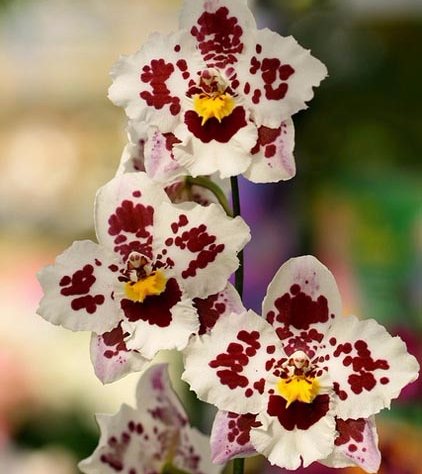

Special period
Like many other flowers, cambria has two periods of life: flowering and dormancy. Let's take a closer look at each of them.


Bloom
This happens most often during the fall-winter period. Bulbs, from which buds then appear, are formed in the warm season. In order for the flower to acquire the correct color and bloom for a long time, it needs to provide additional lighting in the dark.
In addition, to stimulate flowering, during the formation of the bulb, the number of waterings is reduced. After the supply of moisture is stopped for several weeks and only then a slight watering is carried out. All these actions will lead to flowering.
Rest
The hybrid can grow without rest. However, in the absence of additional light and heat, growth slows down significantly in the cold season. At this time, it is recommended to move the plant pot to a cooler place, reducing the amount of watering and feeding. This will help the flower gain strength and, with the onset of warmth, please with flowers.
Planting and transplanting
The plant does not need regular replanting. This procedure should be carried out once every several years. Transplanting is carried out if the roots protrude excessively from the pot or the cambrian soil is overly stale.
For transplanting cambria, the use of an ordinary substrate is recommended. In case of excessively dry indoor air, perlite or vermiculite is added to the soil mixture, with the help of which moisture retention will be ensured in the future. The bottom of the pot is settled by drainage, for example, from large pieces of bark.
Attention! After transplanting the cambria, the bulbs are not sprinkled with the substrate.
It is best to opt for ceramic or plastic pots. The root system of the plant does not tolerate light, which is why it is best to refuse the use of glass containers. The size of the new pot should be several centimeters larger in diameter than the previous one.


After transplanting the cambrian orchid, it is not allowed to disturb it for a week.
Important! Watering cambria after transplanting is allowed only after a week.
Video: cambria transplant
Cambria flowering: proper care during flowering
The Asterisk Orchid pleases those around it with flowering closer to winter, therefore it needs additional lighting. The average flowering period of the species is just over a month. The plant then begins to form new bulbs.A year later, the peduncle appears again. If, instead of flowering, a new bulb is born, you should change the watering regime.
The stimulus for flowering will be the so-called "drying". Reduce watering during the growth of pseudobulbs, after their formation, abandon watering for two weeks, then moisten the substrate and let it stand again without water. This will force Cambria to discard the flower stalk, and then the usual watering procedure can be restored.
Home care secrets
Since the Cambria orchid is characterized by unpretentiousness, any person can easily take care of it at home. To this end, you just need to follow certain rules.
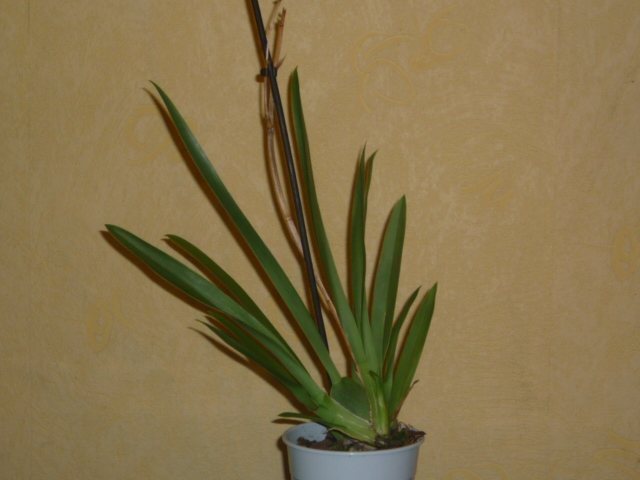

Watering
Like any other plant, the Cambria orchid needs to be watered periodically. In this case, it is necessary to ensure that the soil mixture dries well between procedures. In summer, on average, Cambria is watered once a week.
Important! In winter, when the temperature drops, the frequency of procedures is significantly reduced.
What is the best way to water cambria? Experts recommend bottom watering. For this purpose, a pot with an orchid is placed in a container that is pre-filled with water. For watering the cambrian orchid, it is recommended to use settled water at room temperature.
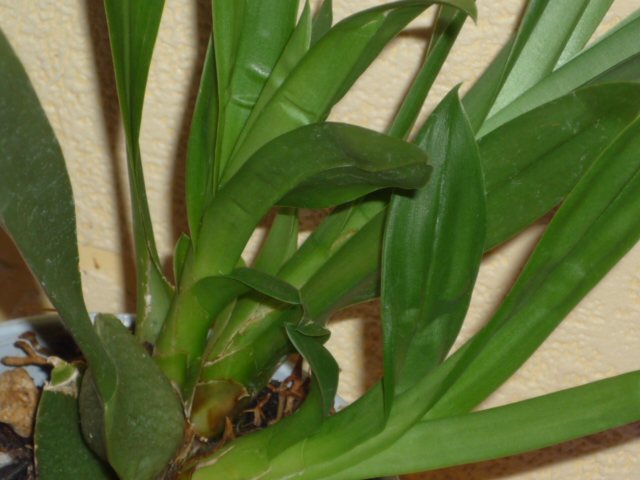

Top dressing
When young shoots appear on the crop, it is necessary to start feeding it, which ends during the flowering period. Cumbria is characterized by a rather tender root system, which is why, in order to avoid damage to it, it is recommended to use a non-concentrated composition of top dressing. The procedure should be carried out no more than twice a month. Top dressing is carried out by immersing the pot in a solution with fertilizer.
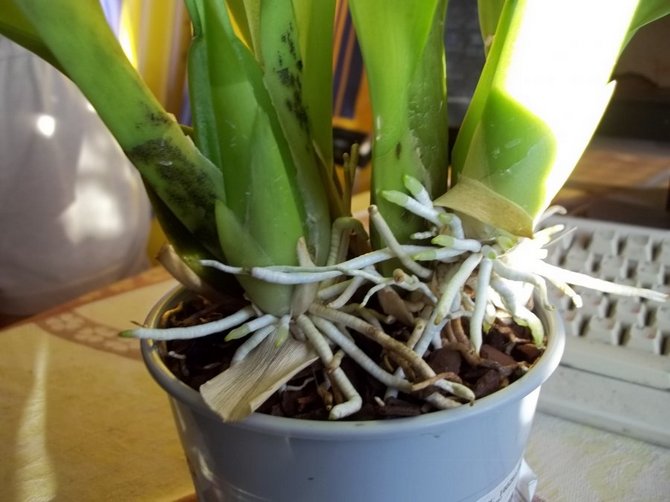

Flowering period
Most often, this type of orchid blooms in the autumn-winter period. In spring and summer, a bulb forms on the shoot, after which a peduncle appears in the axils of the leaves. To ensure the correct color of the flower and increase the duration of flowering, additional illumination of the culture is necessary.
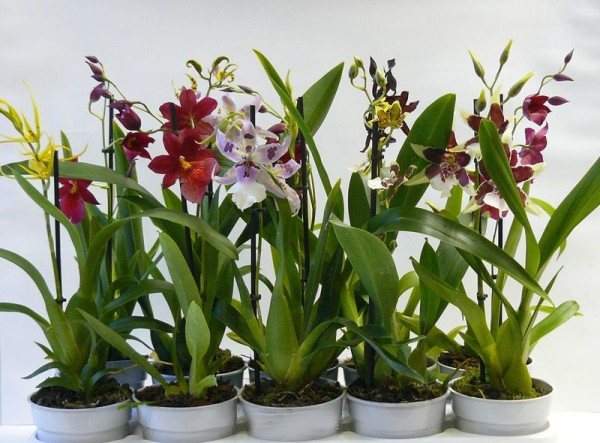

It often happens that the cambrian orchid does not bloom for several years. What to do in this situation? To stimulate flowering, it is recommended to reduce the frequency of watering during the formation of the bulb.
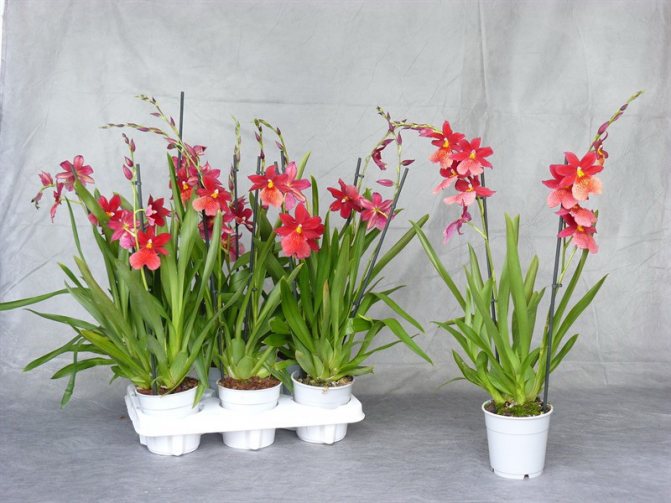

After its formation, it is strictly forbidden to water the orchid for several weeks. After that, light watering is carried out. Thanks to these actions, the orchid will bloom. When one or more peduncles appear in the leaf axils, it is recommended to resume watering.
Note! If at the last stage of the growing season the plant is provided with excessive watering, then this can lead to a lack of flowering.
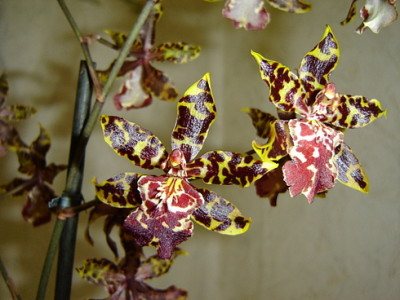

Dormant period
The Asterisk Orchid is characterized by the absence of a dormant period. Despite this, with a decrease in daylight hours in autumn and winter, a decrease in temperature is observed, which leads to a slowdown in crop growth. During this period, watering is reduced and feeding is canceled. After the resumption of growth in early spring, the orchid is provided with full watering and feeding.
There are no special secrets of caring for the cambrian orchid at home, you just need to adhere to all the above tips.
Video: caring for the cambrian orchid at home.
Flowering features
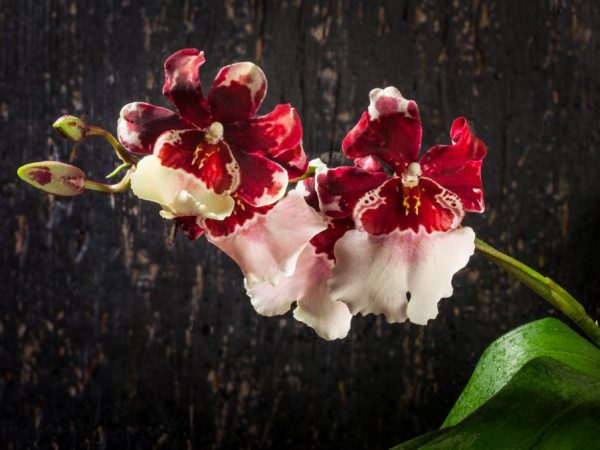

The orchid can bloom all year round
The varieties of Cumbria are capable of blooming at any time, therefore they celebrate the year-round bud formation.
For most, this phase occurs in the autumn-winter season, but there are varieties that bloom in different periods.
The duration of flowering of an individual peduncle is 1-2 months. At the same time, the buds on different orchid arrows can bloom at different times, which explains the year-round budding phase.
At the end, the pseudobulb dries up and gives rise to a new sprout with the next life cycle, incl. and re-budding.
Stimulating flowering
In the absence of budding, the indoor orchid can be stimulated so that it sprouts with inflorescences. This is done with the help of a temperature difference, lowering the degree at night to 13-15 points for 2 weeks.
Young orchids should not be stimulated, because a fragile plant does not always cope with drastic changes in the microclimate.
Other ways to stimulate homemade Cambria to start flowering:
- reduction of watering at the stage of pseudobulb growth, followed by resumption and termination again;
- the use of preparations with succinic acid, which acts as a natural stimulant for the development of vegetative mass in orchids.
Diseases and pests
With improper and untimely care at home for the cambrian orchid, a variety of diseases and pests can appear on it.
| Name of the disease | Control measures |
| Powdery mildew | Belongs to the category of fungal infections. This disease is characterized by the presence of a characteristic white coating on the leaf. A disease occurs with an excess of moisture. If the flower is not treated in time, its death will be observed. For the treatment of the disease, the "Skor" insecticide is used in accordance with the instructions. |
| Rust | This disease affects the foliage of the orchid. On the inside of the foliage, spots of a reddish hue appear. When this disease appears, it is recommended to remove the lesion with a clerical knife. A 25% alcohol solution is used to treat the cut points. Treatment of the disease is carried out by "Skor", "Ridomil", "Mikosan". |
| Anthracnose | At the initial stages of the course of the disease, small spots appear on the foliage of the culture. After a certain time, they turn black and have a concave surface. After that, there is a yellow or pink bloom on the spots. A disease appears with an excess of air humidity. In order to avoid the appearance of the disease, it is recommended to periodically ventilate the room. And also in the axils of the foliage, it is necessary to regularly remove the collecting liquid with a sponge, cloth or soft paper napkin. The fight against the disease is carried out with the use of insecticides. |
| Pests | On the orchid, the most common appearance is the scale insect, aphid and the worm. The last one is quite dangerous and can lead to the death of the plant. In most cases, there is an infection of weak indoor cambrian flowers that are not properly cared for. When pests appear, it is recommended to treat the culture with soapy water. The fight against them is carried out with the use of appropriate insecticides. Prevention is carried out using a universal remedy, which is developed on the basis of Neem tree oil. |
In order to avoid the appearance of diseases and pests, it is recommended to regularly carry out preventive treatments.
Resuscitation of plants without roots
Thanks to the efforts of breeders, it is possible to save a plant that has no roots. For resuscitation of cambria without roots, most often they are placed in water, to which growth stimulants are previously added.


This procedure helps cambria grow roots. After the appearance of the first roots on the culture during the resuscitation of cambria in water, it is transplanted into a nutrient soil mixture.
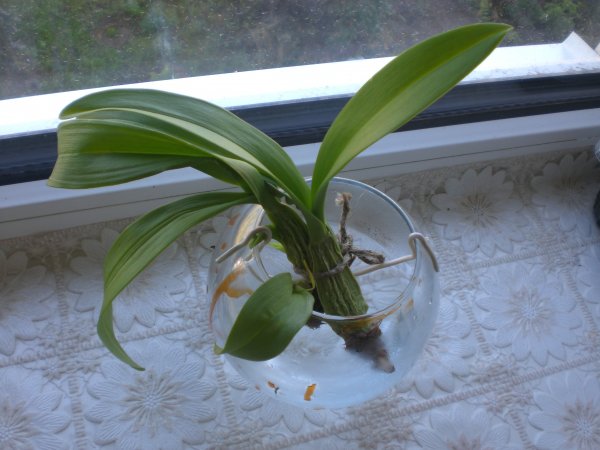

And also cambria without roots can be immediately planted in the ground. For such resuscitation, it is preliminarily placed in a growth stimulator solution.After this, the cut sites are treated with wood ash and the cambria orchid is planted in the ground.
Solving common growing problems
Inexperienced growers, when growing a cambrian orchid, are faced with many problems, which must be eliminated immediately so as not to destroy the plant.
Care errors
Many problems are associated with non-compliance with the rules of flower care.
Pseudobulbs wrinkle
This is due to a lack of moisture or rotting of the root system. In the first case, it is necessary to normalize the irrigation regime, in the second, to remove the plant from the substrate, remove rotten roots.
Ladder growth
This is a sign that there is not enough room for roots in the pot. Transplanting into a larger pot is required. To support the above-ground part, a support is placed.
Pseudobulb cracking
The problem is overflowing the substrate at low temperatures and lack of lighting. The solution is to normalize the level of illumination, temperature indicators and irrigation regime.
Leaves turn white, thicken or change color
This usually happens with excessive feeding. Cambria is extremely sensitive to excess nutrients. Therefore, fertilizers are used carefully, a weakly concentrated solution is made.
Yellow foliage
The problem is related to the direct hit of ultraviolet rays on the sheet plates. Shading required. The plant is rearranged in a place where the lighting is diffused.
Pests
Most often, cambria suffers from attacks by ticks, aphids and scale insects.
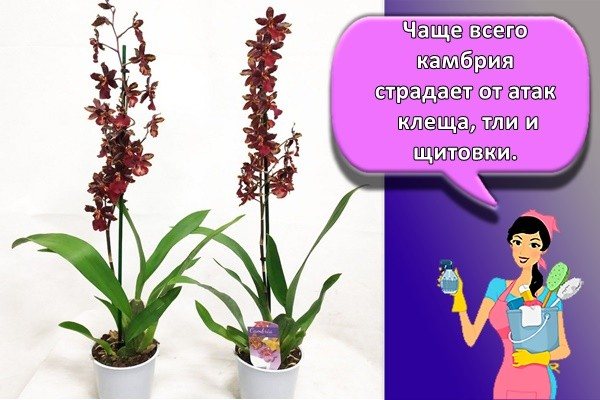

Spider mite
Signs of damage - a cobweb on the underside of the leaf plates, dark dots on the leaves. Treatment consists in using strong insecticides - Fitoverm, Actellik, Confidor. To prevent tick damage, the plant is periodically treated with a mild soapy solution.
See also
Rules for growing and caring for indoor ivy at home
Shield
Symptom - covering the surface of the stems with small brown plaques. Insects are removed from the shoots by hand with a cotton swab, wiped with soapy water. Insecticides are of little help, since adult pests are protected from external influences by a shell.
Aphid
Small insects suck out juices from the plant, slowing down its development. An effective means of control and prevention is a soap solution. In an advanced case, insecticides are used. Aphids do not like citrus scent, so you can put lemon or orange peels on the surface of the substrate. For prevention, it is important to maintain optimal air humidity.
Diseases
With poor quality and unsystematic care, cambria gets sick.
Anthracnose
Fungal disease that occurs with excess moisture and lack of ventilation. Symptom - spots on the leaves that grow, darken, then become covered with a pinkish bloom. Fight infection with fungicides. For prophylaxis, the room is regularly ventilated, the accumulated liquid is removed from the leaf sinuses after spraying with a cotton swab or napkin.
Powdery mildew
Fungal disease, accompanied by the appearance of a whitish plaque on the leaf plates, occurs with excessive moisture. Fungicides are used to fight the fungus. If untreated, the plant dies.
Rust
A dangerous fungal infection in which the leaves are covered with red spots. The diseased parts of the plant are cut off. Places of cuts are treated with 25% alcohol. Treat the infection with fungicides Skor, Ridomil.
Resuscitation of an orchid without roots
Cambria is one of those species that can be saved even after all the roots have died. The dying plant is removed from the substrate, the decayed roots are cut off, the sections are treated with crushed coal.


The orchid is placed in a container of water, into which a root growth stimulator is added according to the instructions. When the first roots appear, the plant is planted in a nutritious soil.
Reproduction
The method of dividing the bush and reproduction by children is most often used for reproduction of the cambrian orchid.Let's talk about each method in more detail.
Reproduction by dividing the bush
This procedure is carried out during plant transplantation. Reproduction of cambria is carried out at the end of the flowering culture.
- Initially, it is necessary to remove the bush from the pot and clean it from the earthen coma.
- It is recommended to carefully examine the root system. If there are diseased roots, they are removed.
- The flower is divided into several parts.
- It is recommended to treat the cuts with wood ash or a solution of potassium permanganate.
- After that, each separate part of the bush is planted in a separate pot.
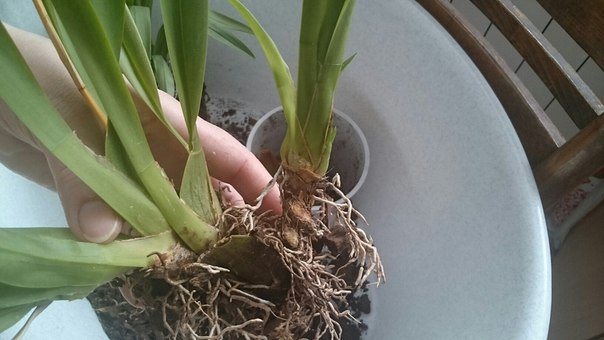

Reproduction by children
Thanks to the efforts of breeders, the plant has children, which are widely used for reproduction of the cambrian orchid at home. When several leaves form on children, they must be separated from the mother bush.
Some growers place cambrian babies in water, to which growth stimulants are added. After the appearance of the first roots, the flower is planted in a pot. It is also possible to plant cambrian babies in the ground immediately after separation from the mother bush.
The reproduction process of an orchid is quite simple, which any grower can do. Due to the presence of several ways of reproduction of culture, a person can choose the most acceptable option for himself.
Video: reproduction of cambria.
The Cambria Orchid is a very beautiful flower. Due to its ease of care at home, this plant can decorate the windowsills of various premises. To ensure the growth and flowering of the culture, it is recommended to adhere to the basic rules of care.
Common varieties
Orchid - home care
There are several varieties of this beautiful orchid. The most popular ones are:
- Cambria Mix. This is the name of a hybrid with a non-natural origin. The name is used commercially to refer to another subgroup of colors;
- Beallara Margarita Holm is a hybrid characterized by rather tall stems with a large number of flowers. The petals are dark red with white spots and strokes. Another difference is that this species blooms all year round, regardless of time. During flowering, a pleasant aroma is noted;
- Catatante Pacific Sun Sport. The hybrid is obtained by crossing several species. It is easy to recognize by its characteristic oval-shaped pseudobulbs. The color is varied: from orange to purple with white specks and strokes. Sharp leaves;
- Colmanara Tropic Jungle. Differs in long and thin leaves. The variety is obtained by crossing several different species. The orchid blooms twice a year, the number of flowers on a peduncle can reach 10. The colors of the petals vary from red and brown to yellow and white. There is a strongly marked outgrowth of the lip of a white-red color;
- Odontoglossum Stirbik. The hybrid variety perfectly perceives the coolness, therefore it grows easily in an apartment environment. Leaves are lanceolate, their number increases with age. Flowers are formed constantly, on one peduncle there are up to 7 pieces, they are very similar to asterisks. There are yellow, red, white;
- Black Cat. An unusual hybrid with very interesting flowers. The petals are black, with a yellow border around the edges.
These are just some of the cambrian orchid hybrids. Breeders continue to crossbreed different varieties and get new ones.
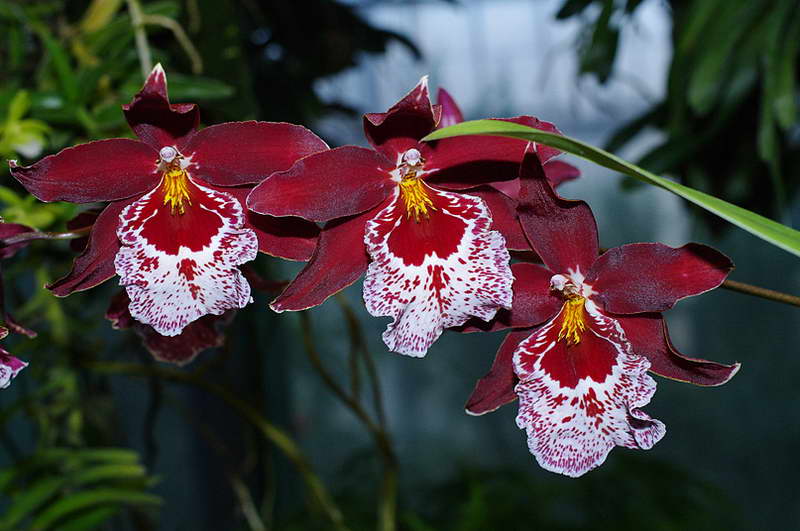

Cambria is not like the usual tropical orchids.

